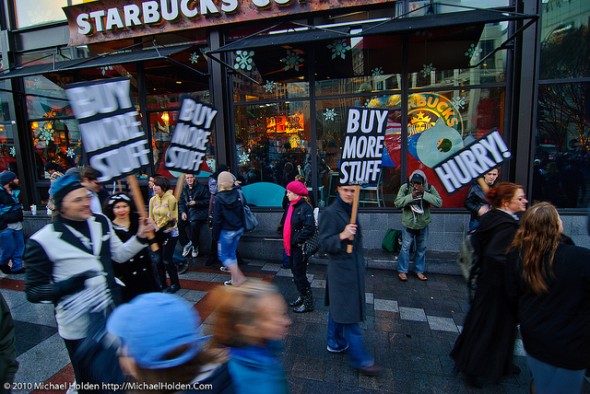The below post originally appeared on The Source.
Spend $200 on a great Christmas gift at the big box store and get a $50 gift card. Sounds like a great offer. It may, in fact, entice you to spend more than you normally would, warns an Olin Business School marketing expert.

Cynthia Cryder
“Price promotions that feel too good to be true are always an opportunity for consumers to take an extra moment for reflection,” said Cynthia Cryder, associate professor of marketing at Olin Business School. “Instead of thinking about how much money they are ‘saving,’ consumers might want to stop to ask themselves: How much am I actually paying for this product, and am I willing to pay that much?”
Cryder and co-author Andong Cheng, of the University of Delaware, examined the phenomenon of this “mental discounting” in a new paper, “Double Mental Discounting: When a Single Price Promotion Feels Twice as Nice,” accepted in the Journal of Marketing Research.
With certain price promotions, such as a receiving a gift card to spend in the future, consumers mentally deduct the gift card’s value from the initial purchase as well as from the second purchase when they use the gift card. Multiple mental deductions based on a single price promotion result in consumers’ perceptions that their costs feel lower than they actually are, and can increase spending, Cryder said.
“Consider a situation in which a college student purchases a $900 Macbook and receives a $100 gift card to spend in an Apple store in the future,” Cryder and Cheng wrote in the paper. “Feeling confident that she will use the gift card, the student may mentally reduce the laptop cost and think: ‘I am spending only $800 (instead of $900) on this laptop because I am receiving $100 worth of credit back in my pocket.’
“Now imagine that later, the student is back in the store purchasing a $300 iPad. At this point, she applies the $100 gift card, resulting in a final $200 charge for the iPad,” they wrote. “She may think: ‘I am spending only $200 (instead of $300) for this tablet, because my gift card covers some of the cost.’ In total, this consumer has paid $1100 for the laptop and tablet, yet, because she mentally applied the price promotion to both purchases, she may feel as if she paid substantially less.”
According to industry research, Cryder said, businesses will load $14.5 billion onto promotional credit offers in 2017, triple the amount from 10 years ago.
“These promotions create opportunities for retailers, and consumers should carefully consider these offers before taking advantage of them,” Cryder said. “Although consumers might feel like they are spending less, these offers can sometimes encourage them to spend more.”
By Neil Schoenherr, Washington University in St. Louis Public Affairs




 “There is some research evidence that indicates consumers are focusing less on material values and more on acquiring experiences. It might be that they are actually shopping for an experience. Research says that when consumers spend money on experiences, they actually end up being happier and more satisfied with their life than when they are purchasing material goods. So there might be a silver lining in all of this. I just wonder how long will it take until Thanksgiving is completely a shopping day and it turns into Black Thursday.”
“There is some research evidence that indicates consumers are focusing less on material values and more on acquiring experiences. It might be that they are actually shopping for an experience. Research says that when consumers spend money on experiences, they actually end up being happier and more satisfied with their life than when they are purchasing material goods. So there might be a silver lining in all of this. I just wonder how long will it take until Thanksgiving is completely a shopping day and it turns into Black Thursday.”
 “With the media spotlight on retailing during Thanksgiving weekend, price cutting and door busters are forms of MAD (Mutual Assured Destruction) where retailers try to outdo one another by slashing gross profit to unsustainable levels. All want sales momentum going into the holiday season, which accounts for a huge percentage of retailer sales and profits. With a much shortened holiday shopping season – a very late Thanksgiving means four or five fewer shopping days this year, retailers are starting even earlier.”
“With the media spotlight on retailing during Thanksgiving weekend, price cutting and door busters are forms of MAD (Mutual Assured Destruction) where retailers try to outdo one another by slashing gross profit to unsustainable levels. All want sales momentum going into the holiday season, which accounts for a huge percentage of retailer sales and profits. With a much shortened holiday shopping season – a very late Thanksgiving means four or five fewer shopping days this year, retailers are starting even earlier.” “If no one does anything, then one retailer may correctly think that he will gain competitive advantage by engaging in this ‘Christmas Creep’,” says Chakravarthi Narasimhan PhD, the
Philip L. Siteman Professor of Marketing. “But, if everyone thinks that way, everyone follows suit and the industry as a whole may or may not be better off.”
“If no one does anything, then one retailer may correctly think that he will gain competitive advantage by engaging in this ‘Christmas Creep’,” says Chakravarthi Narasimhan PhD, the
Philip L. Siteman Professor of Marketing. “But, if everyone thinks that way, everyone follows suit and the industry as a whole may or may not be better off.”